Looking for ways to lower your tank’s pH level safely?
Good, you’re in the right place.
In this article, you’ll learn how to safely lower the pH in your aquarium so you don’t further stress your buddies.
But what’s more important, is that these techniques will help you maintain a consistent pH level.
Let’s get started.
Warning: Before you decide to lower the pH in your aquarium, you need to consider whether or not you actually NEED to. Tank bred fish adapt to a range of parameters and it’s more important to keep these consistent than to chase a “ideal” number. If you’re worried your pH is 7.5 and you’ve read the ideal pH is 7.0, don’t worry about messing with your water chemistry.
What is pH?
Rack your brain hard enough, and you might remember your teacher mentioning water (H2O) is made up of hydrogen and oxygen molecules. In water, small numbers of molecules split up, some lose a hydrogen and become hydroxide ions (OH-).
In pure water, there are an equal number of hydrogen ions (H+) and hydroxide ions. Now, when a basic (alkaline) or acidic substance dissolves in your aquariums water, it will alter the balance of ions; changing the pH.
An acid substance will increase the amount of hydrogen ions, lowering your waters pH. A basic substance will “soak up” the hydrogen ions, resulting in more hydroxide ions and raising the pH level in your aquarium.
So pH is the measurement of how acidic or basic the water solution in your aquarium is.
The pH Scale
Acidity and alkalinity are measured on the pH scale because a strongly acidic solution can have one hundred trillion times more hydrogen ions than a strongly basic solution. And visa versa.
That’s too many 0’s to comprehend. Thankfully, some clever scientists created the pH scale to make it easy.
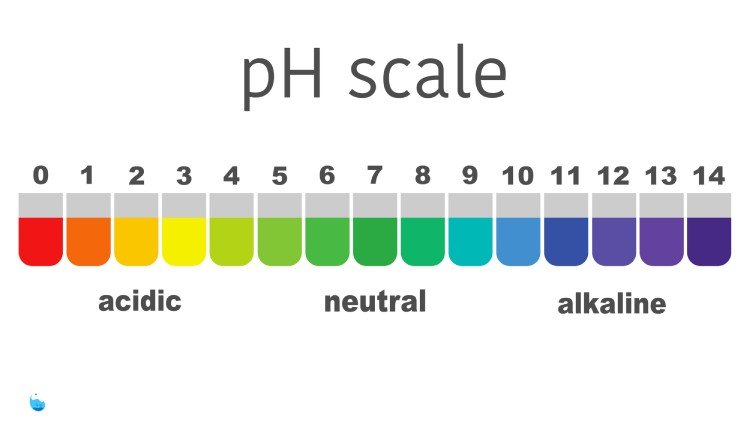
pH is measured on a scale of 0-14: 7 is neutral, below is more acidic and higher is basic (alkaline).
Each number on the scale represents difference 10 fold, for example, if your aquarium has a pH of 6 it’s 10 times more acidic than a tank with a pH of 7. Or if it’s got a pH of 5, it’s 100 times more acidic than a pH of 7.
How to Safely Lower Your Aquariums pH Level
I recommend altering the pH levels in your tank using natural methods. Using store bought chemicals can change the pH levels in your tank too quickly and drastically. This is likely to stress your fish and cause illness or death.
You can try some of these safe methods:
- Peat Moss
- Driftwood
- Cappata Leaves
- Reverse Osmosis
1. Peat Moss
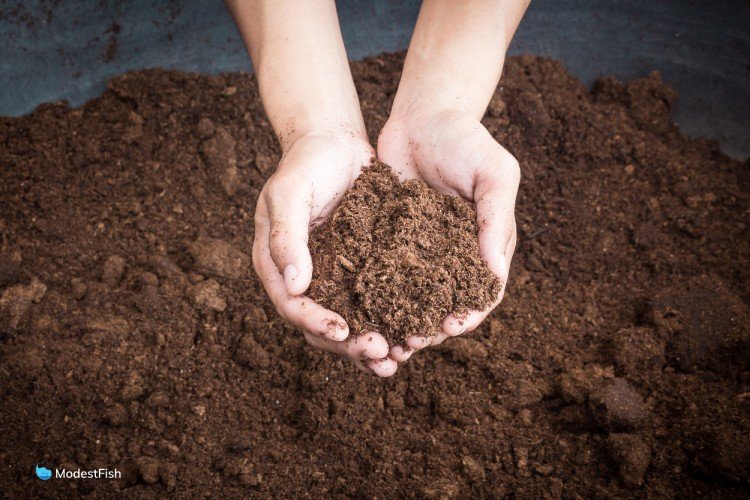
Peat is a wonderful natural way to safely lower your aquarium’s pH.
The only downside being, it will discolor your water. The brown tint will not harm your tank, but many people don’t like the look of it in an aquarium.
Peat will release tannic and gallic acids into your aquarium, which will neutralize the bicarbonates in the water, reducing the KH, and therefore, the pH.
There are two ways to use peat to reduce your pH:
- Place peat in your filter
- Filter your water through peat outside of the aquarium
When you’re putting peat in the filter, there’s no definitive answer for how much you’ll need to use. It will depend on factors like: how big your tank is, how hard your water is and the quality of the peat. So it’s best to start off by placing a small clump in a mesh bag and putting this in your filter. Then, monitor your pH over the next few weeks. You can then add more if it’s needed.
The peat will tint your water, at least a little bit, if you use this method. And you’ll need to monitor your pH fairly regularly to make sure it’s not going too low.
If you’re going to filter your water with peat outside of your tank, it’s best to place the peat in a fine sieve, or even a coffee filter, and drip the water through the peat and into a bucket.
The acids in the peat will reduce the pH, and you can then filter the water with activated charcoal to remove the discoloration from the tannins.
I like this method better because you can test the pH of the water before you put it in the tank. This gives you more control over how much you’re changing the pH of the tank.
If the peat takes the pH too low, you can mix in tap water and get the pH exactly where you want it and then add it to the tank.
Get the water you put in to the pH you want the whole tank to be at. Each water change will get the tank closer to the pH you want.
Also, if you don’t like the look of tannins in the water, you can filter the peat water with activated charcoal and it will remove the stain from the water. The pH will still be lowered because the tannins will have already neutralized the bicarbonates in the water.
Make absolutely sure that any peat you use does not have any additives, like antifungal agents. These chemicals can be deadly to fish and invertebrates. Look for completely natural, untreated peat.
2. Driftwood
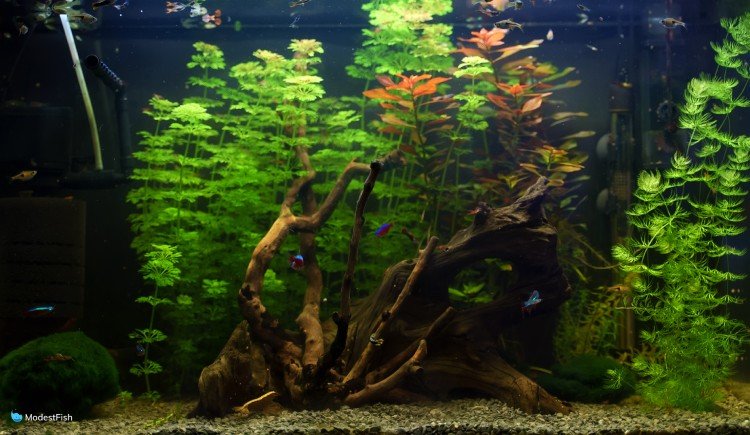
Adding some natural driftwood to your aquarium will slowly and safely lower its pH levels. Like peat, driftwood will release tannins into your tank’s water, reducing the pH.
However, because it contains tannins, it will also color your water yellow/brown.
Don’t just go adding driftwood to your tank without prepping it, as it could potentially put out huge amounts of tannins all at once.
Also, not all driftwood is the same, so you should make sure it’s safe for aquarium use. Driftwood sold for reptiles may look fantastic for your tank, but it could contain chemicals which are harmful to your fish.
But, be aware that some driftwood, especially things like Mopani wood, can leach a lot of tannins into the water, making your tank look like a glass of iced tea.
I recommend that you either boil driftwood to remove excess tannins, or soak it in salted water (½ cup per gallon of water) for several days, before placing it in your tank.

Last update on 2024-04-26 / Commissions Earned / Images from Amazon Product Advertising API
3. Catappa Leaves
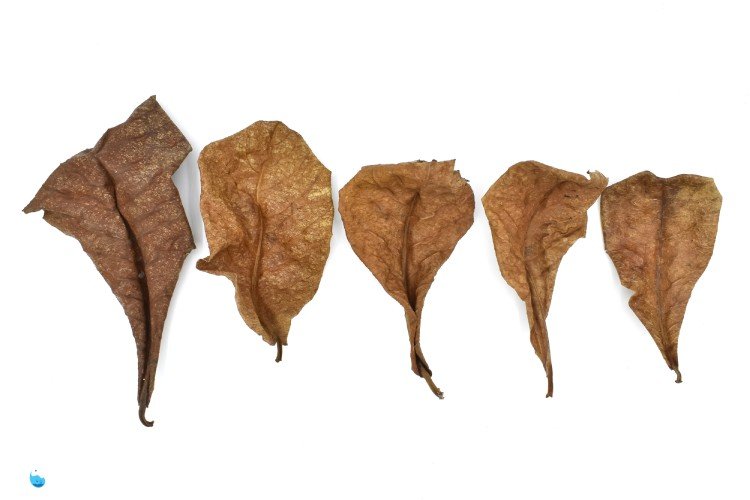
Also known as Indian Almond leaves or ‘the poor mans water conditioner’, due to their ability to alter water conditions in an aquarium. When you place them into your aquarium, they’ll slowly start to decompose and release tannins.
If you’re not a fan of having leaves in your tank, you could soak the leaves separately and add the stained water to your tank during a water change.
Not only will they safely lower the pH in your tank, it’s also suggested that they have antibacterial properties which come in handy if your fish are suffering from fin rot or you’re raising vulnerable fry.
Just like Peat Moss and Driftwood, they will turn your tank’s water yellow or brown so you can try soaking them before adding them to your tank. It may help to reduce some color change.
Or, you could consider embracing the color change, as it actually mimics the natural habitat of many species.

Last update on 2024-04-26 / Commissions Earned / Images from Amazon Product Advertising API
4. Reverse Osmosis
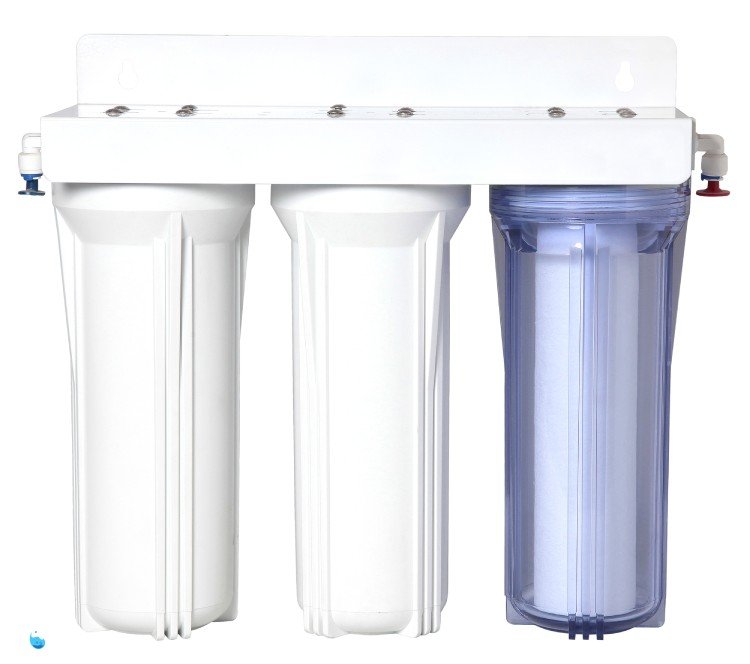
Also known as Indian Almond leaves or ‘the poor man’s water conditioner’, due to their ability to alter water conditions in an aquarium. When you place them into your aquarium, they’ll slowly start to decompose and release tannins.
If you’re not a fan of having leaves in your tank, you could soak the leaves separately in hot water and add the stained water to your tank during a water change.
Not only will they safely lower the pH in your tank, it’s also suggested that they have antibacterial properties which come in handy if your fish are suffering from fin rot or you’re raising vulnerable fry.
Most Betta breeders in Asia use Indian almond leaves as their primary go-to for sick fish.
Just like peat and driftwood, catappa leaves will turn your tank water yellow or brown. If the color bothers you, you can soak the leaves in hot water, and then later filter that water through activated charcoal to remove the brown color.
The tannins will have already eaten up the bicarbonates in the water, so the pH will still be lowered. But, filtering out the tannins and other organic compounds will negate the health effects from the catappa.

Last update on 2024-04-25 / Commissions Earned / Images from Amazon Product Advertising API
Don’t Chase the ‘Perfect’ pH. Keep it Stable
It’s important that you consider the current condition of your fish before you start trying to alter the pH levels in your tank.
Here’s why:
Just because you read in a textbook the optimum pH for your fish is 7.0 and your tests come out at 7.4, doesn’t mean you should spring into action.
If your fish aren’t showing any signs of distress, it’s better to keep the pH stable.
Your fish will likely thrive at a constant level between 6.6 and 7.4, maybe even between 6.2 and 7.8.
It’s the drastic swings in pH that you need to avoid, as these will result in your fish becoming stressed. It’s better to maintain.
It’s better to have a pH value of 7.4 than a pH which fluctuates between 6.6 and 7, even if the textbooks say your fish prefers 7.
Performing partial water changes and routine maintenance is key to keeping your pH levels stable.

Thanks for your guidance, very interesting reading.
I’m in the process of upgrading to a 250ltr tank.
Keep Discuss fish in my current 125 ltr tank and ph is 6.8 which is ideal for them but the 250ltr is 7.8.
After a month of being set up and drift wood and peat in the filter still no change in the PH!
Turned off the air now to see if this makes a difference. Any ideas or is just a case of playing the waiting game.
As of yet no fish have been added until I can get the PH to deflate.
I look forward to your feed back for advice.
Please note I have no intentions of using Ph down.
Thank you very much for your comment, Garry. Have you tried placing the driftwood and peat in your aquarium as opposed to just in the filter?
interesting ! Thanks for information !
Nice article! I am glad you stressed not chasing an ideal PH, but a stable one. I am moving from an area with PH in the range 6.8 to 7.2 lake water, to a town on well water that is moderate hard with ph 7.8 to 8.2 (varies from test to test). I believe it is important for aquarists to select fish that will do well in local water parameters. Fortunately, the fish I have can tolerate the differences. Sometimes it is easier to select fish that will thrive in local water parameters, rather than fussing to alter water. While altering water parameters can be done, it requires constant monitoring and diligence. For example, I would not try to maintain a tank of Discus where I am moving to! Some may love the challenge, but I would rather take a simpler approach. 🙂
this is great
good luck
your data is very helpful
Thanks for this, it’s very helpful. I have a stable PH but it’s around 8 .
I only keep fairly robust community fish, tetra, gourami, plecos etc.
Would a stable 8 be OK
Thank you for the advise,great help.
Need one in my house! Nice post! Thank for sharing!!
This post is really helpful for me
Very good information. Thanks